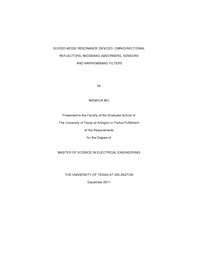
ATTENTION: The works hosted here are being migrated to a new repository that will consolidate resources, improve discoverability, and better show UTA's research impact on the global community. We will update authors as the migration progresses. Please see MavMatrix for more information.
Show simple item record
| dc.contributor.author | Wu, Wenhua | en_US |
| dc.date.accessioned | 2014-03-10T21:17:00Z | |
| dc.date.available | 2014-03-10T21:17:00Z | |
| dc.date.issued | 2014-03-10 | |
| dc.date.submitted | January 2011 | en_US |
| dc.identifier.other | DISS-11422 | en_US |
| dc.identifier.uri | http://hdl.handle.net/10106/24029 | |
| dc.description.abstract | In this thesis, a series of guided-mode resonance (GMR) devices are developed and optimized in the optical spectral region. Some of these devices are designed by inverse algorithms such as genetic algorithm and particle swarm optimization. One-dimensional subwavelength silicon and germanium gratings providing high omnidirectional reflectivity within specific band are designed respectively for TE and TM polarization. A simple amorphous silicon waveguide grating is proposed to enhance the absorbance for solar cells by 60% comparing with unpatterned structure. Another presented grating absorbs light nearly totally in the ~ 0.3-0.6 ìm wavelength band for all incidence angles independent of polarization, namely wideband omnidirectional absorber. GMR photonic sensors are also discussed and demonstrated mainly on a post analysis method that can improve the testing accuracy. It is a back-fitting model that helps to differentiate the biochemical target from outside environmental disturbers. In addition, GMR filter showing extremely narrow linewidth ~10 pm is also presented. | en_US |
| dc.description.sponsorship | Magnusson, Robert | en_US |
| dc.language.iso | en | en_US |
| dc.publisher | Electrical Engineering | en_US |
| dc.title | Guided-mode Resonance Devices: Omnidirectional Reflectors, Wideband Absorbers, Sensors And Narrowband Filters | en_US |
| dc.type | M.S. | en_US |
| dc.contributor.committeeChair | Magnusson, Robert | en_US |
| dc.degree.department | Electrical Engineering | en_US |
| dc.degree.discipline | Electrical Engineering | en_US |
| dc.degree.grantor | University of Texas at Arlington | en_US |
| dc.degree.level | masters | en_US |
| dc.degree.name | M.S. | en_US |
Files in this item
- Name:
- Wu_uta_2502M_11422.pdf
- Size:
- 1.226Mb
- Format:
- PDF
This item appears in the following Collection(s)
Show simple item record


